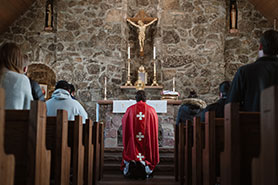Communion in the Catholic Church
02-03-2021
What is the Holy Eucharist in the Catholic Church? Well, of the seven sacraments, Holy Communion is the most important and central to the Catholic church and its members.
Catholic Holy Communion is also called the Holy Eucharist - or just Communion or Eucharist. Communion in the Catholic Church is when Catholics drink the blood and eat the body of Christ. Bread is consecrated to become Jesus’ body and church wine is consecrated to become Jesus’ blood. This is called “transubstantiation” - when the bread and church wine become Jesus. For Catholics, this is not a symbolic process. Church wine and wafers are really and truly the blood and body. This is what makes the sacrament so divine - God literally becomes a part of a person who receives it.
To receive the Communion in the Catholic Church, several conditions must be met:
- Recipients must be in a state of grace, i.e recipients must be living faithfully and also must have made a confession since their last serious sin.
- Recipients should not eat or drink for one hour prior to receiving the host and church wine (body and blood).
- Recipients must believe in transubstantiation and must be “in communion” (have the same beliefs) with the church.
If these conditions are met, then Catholics are encouraged to receive Communion often. Frequent Communion increases one’s love for God and for others, which expresses itself in action. In turn, our actions - which were born from Catholic Holy Communion - makes us more like Christ.
Communion in the Catholic Church is offered at each mass. In the Roman Catholic church, after the priest consecrates the bread and church wine, the congregation is invited (pew by pew, in order) to walk towards the altar or sanctuary. The priest or altar servers then offer the body and blood of Christ to each person who has come forward. Catholics can choose to take both the host and the church wine (often served in a communal cup or chalice) or just the host. The church states that full communion is possible just via the body of Christ, so partaking in the drinking of Jesus’s blood is not required. Some congregations may not offer consecrated church wine (blood) except in special circumstances - there are various reasons for this, but it often has to do with ensuring communion can be delivered in a reasonable amount of time. The priest or server will say, “Body of Christ” or “Blood of Christ” - recipients respond, “Amen” and then return to the pew and kneel for prayer until Communion is over. Eastern Rites of the Catholic Church handle Eucharist in a different way, although the basic tenets are the same in terms of transubstantiation, etc.
Catholic Holy Communion is both a serious and a joyous sacrament (as most sacraments are). Understanding and engaging with Communion deeply is an important step in one’s faith life. And, to be clear, that learning and understanding (especially on a spiritual level) can and must continue long after one’s First Communion. Learn more about Communion in the Catholic Church and Catholicism with our book selection on Catholic Catechism available online today!

